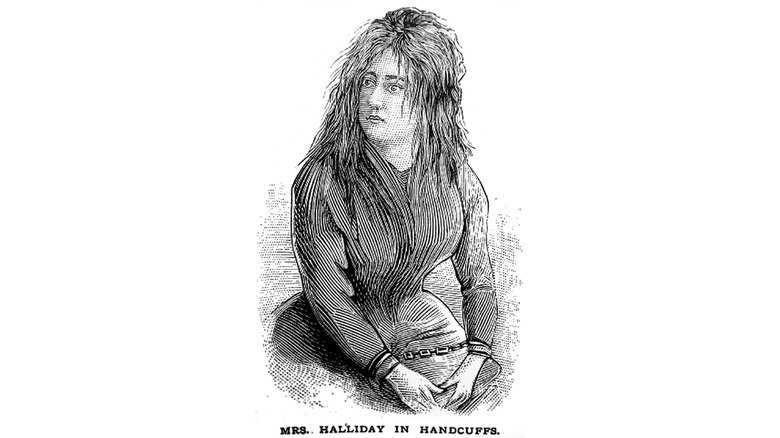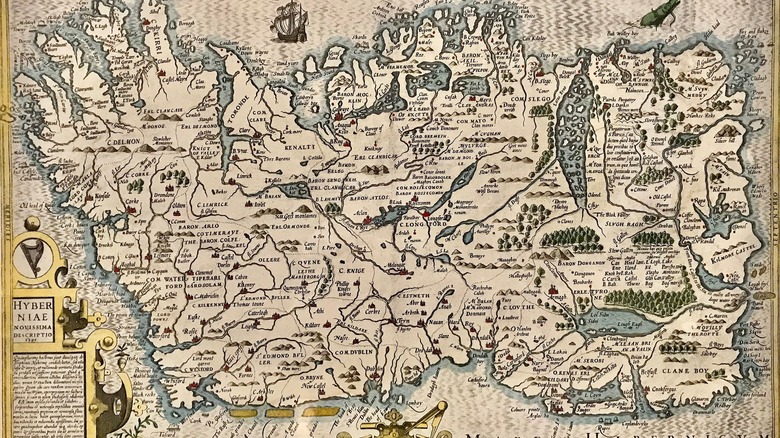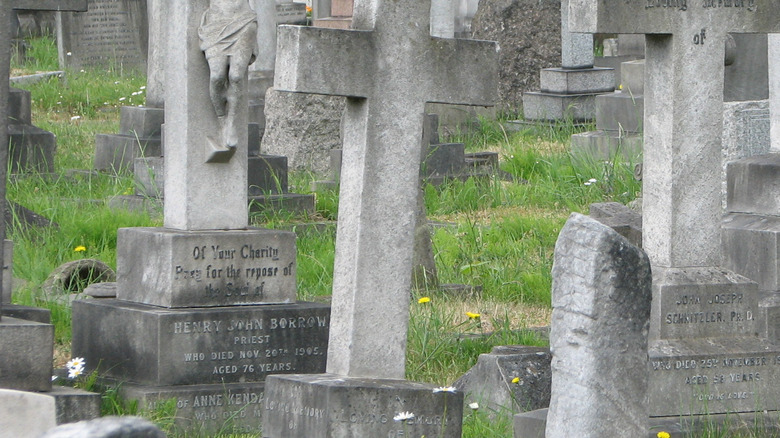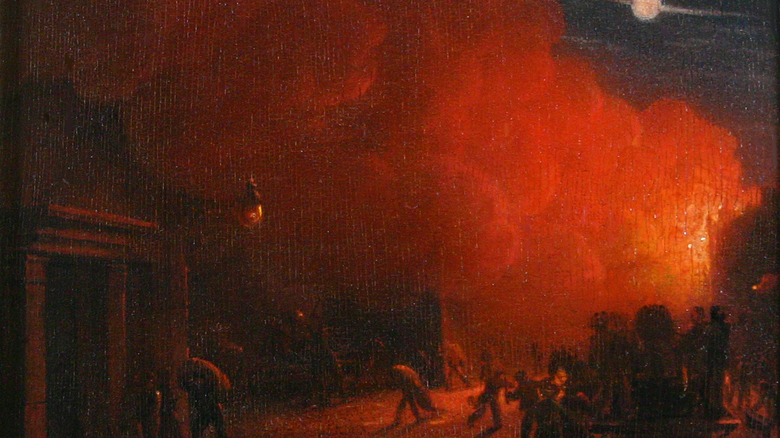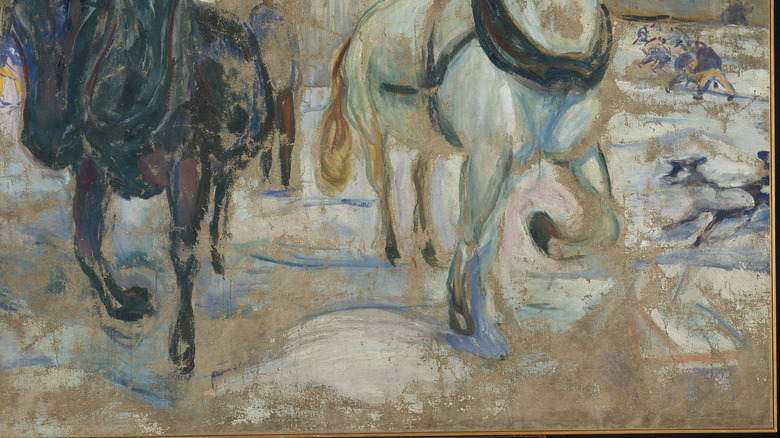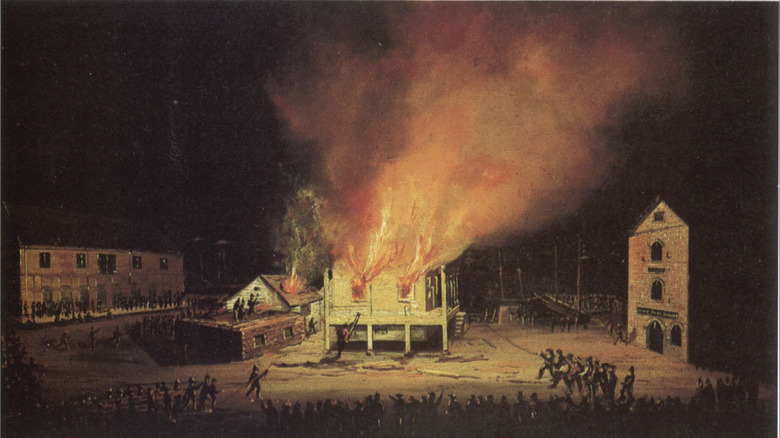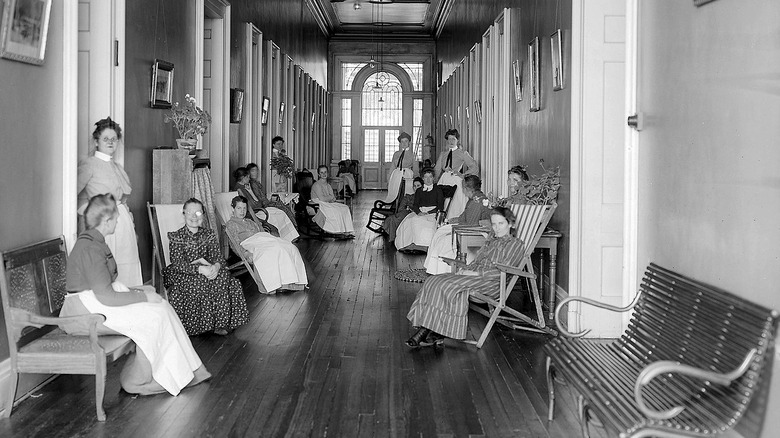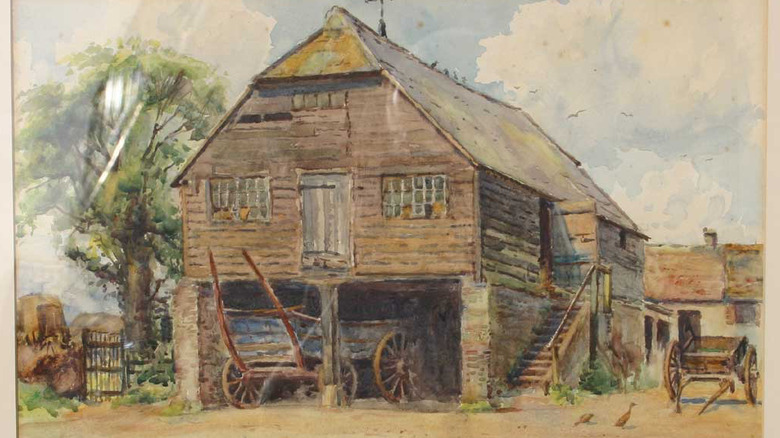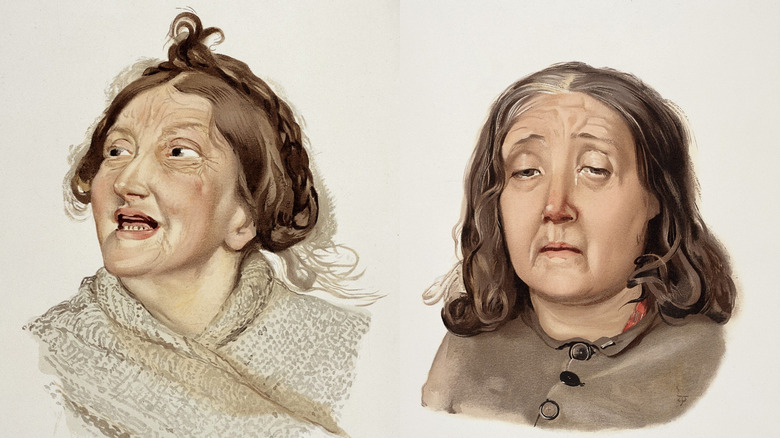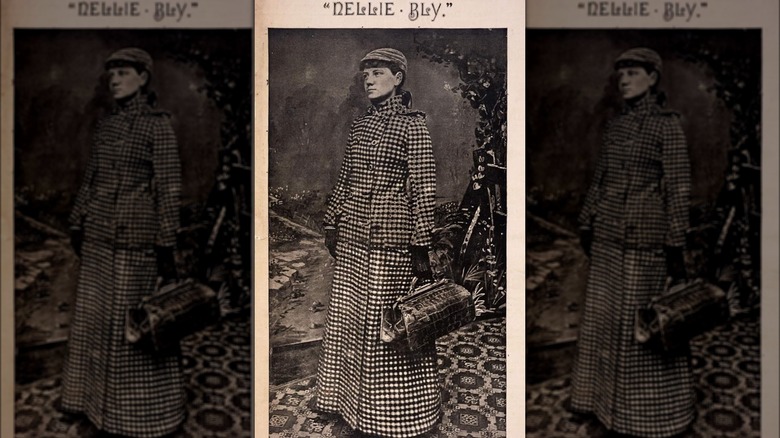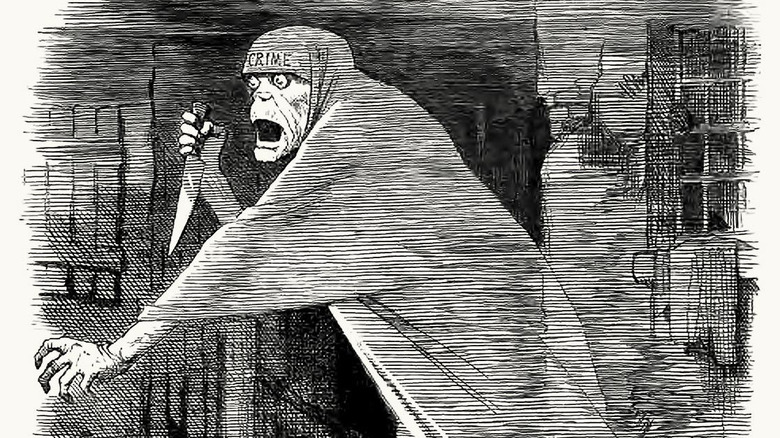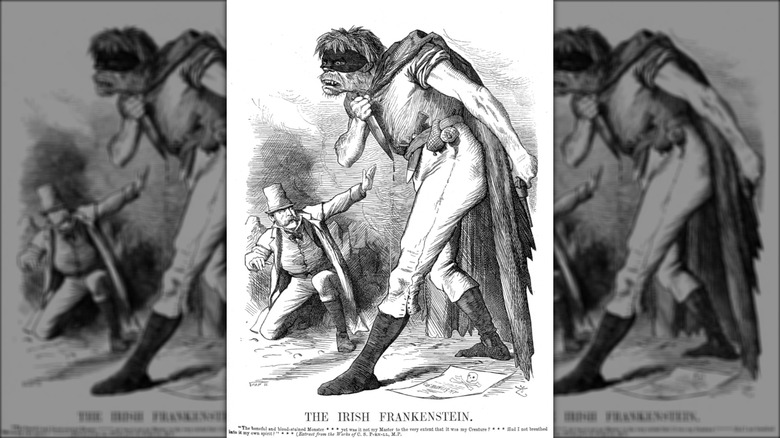Chilling Details About Serial Killer Lizzie Halliday, The Worst Woman On Earth
Evil can find you when and where you least expect it. On the road, in your home, and even, perhaps, in the face of the person you married. For many, that discovery comes as a serious shock. But for the family and wary associates of Lizzie Halliday, it shouldn't have been all that surprising. After all, as a scathing 1918 obituary in the New York Times put it, she was no less than the "worst woman on Earth."
Of course, that title came at the end of Halliday's life, long after she proved just how dangerous she was. In her earlier years, some unfortunates didn't know any better. Just ask her six husbands, quite a few of whom met suspicious ends after crossing paths with her. Or perhaps the poor duo who only thought they would work for her would have something to say. And that's before Lizzie was committed to an asylum like a 19th-century "Batman" villain, where she continued to make headlines for all the wrong reasons.
Ultimately, what made Lizzie so bad? And did she really deserve the title of the worst woman ever? Check out some of the most chilling details of Lizzie Halliday's story and decide for yourself.
Lizzie Halliday emigrated from Ireland
Most sources agree that she was born Eliza McNally in Ireland. Some, such as the New York Almanack, maintain that she was born in 1864 and moved to the United States when she was only three. Then again, true crime author Harold Schechter writes in "Psycho USA" that her birthday was actually in 1859 and she first made it to American shores when she was eight years old. A 1918 article from The Daily Gleaner (via Unknown Gender History) reported that she was born in 1861 and emigrated from Ireland in the 1880s.
To add even further to the confusion, Lizzie Halliday herself may have gotten the timeline of her own life confused. According to Murder by Gaslight, she told her stepson that she had been married in Ireland and killed her first unnamed husband in Belfast. Or perhaps, as some say, the man wasn't her husband at all. Then again, maybe he never existed, being the product of Halliday's mental illness or even a tall tale told by an angry stepson (she likely did kill his father, after all).
However, these sources indicate some commonalities. They all agree that Halliday was born Eliza McNally and, at some point in her early life, traveled from County Antrim, Ireland to the United States. While some tales have it that Lizzie wreaked some havoc back in the British Isles, we are far more certain that she sowed discord and indulged in bloodshed on American soil.
Her first two known husbands died in quick succession
While the details of Lizzie's time in Ireland and her first few years in America get muddled, most accounts agree that, once she started marrying, her husbands fared poorly. According to articles published around the time of her 1894 murder trial (via New York Almanack), her first known husband was Charles Hopkins, who rather confusingly was also known by the alias "Ketspool" Brown. Just two years after their 1879 marriage, which produced a son, Hopkins died. Artemus Brewer, a veteran who was to be husband number two, lasted less than a year after wedding Lizzie.
Though Lizzie was never formally accused of foul play when it came to Hopkins and Brown, her later activities certainly made reporters wonder if there was something more to the two men's deaths. If she really did get rid of them in some way, then perhaps her third husband was the luckiest of all, though perhaps he wasn't the most upstanding fellow. Hiram Parkinson, the husband in question, simply abandoned her after a year of marriage (via New York Almanack).
Lizzie Halliday may have tried to poison her fourth husband
After Lizzie's third husband left her, she then reportedly took up with an associate of her second husband. That man, George Smith, was also a veteran, as per contemporary articles quoted in the New York Almanack. Though it's unclear what happened between the two, accounts state that she attempted to poison him. "Psycho USA" reports that the delivery method was a cup of tea laced with arsenic. Though downing the tea was surely an unpleasant experience, Smith appears to have survived.
Even more fortunately for him, Lizzie does not seem to have been a completist. While he was recovering, she did not plot another attempt, but instead ran off to Vermont. She also took just about everything in the house that wasn't nailed down, as per a 1918 article in the New York Times. She then bigamously married Charles Playstel, having never divorced or otherwise divested herself of Smith. No matter, though — in two weeks, Lizzie was already gone again, disappearing for a time into the Northeast. What she did between her dalliance with Playstel and her next appearance remains unknown.
She resurfaced in Philadelphia
Eventually, Lizzie reappeared in Philadelphia, quite a ways from her previous life in Vermont. As per the New York Almanack, once there she arranged to stay with the McQuillan family, whom her own family had known back in Ireland. While she was settling in, the entrepreneurial spirit apparently took hold of her, as she opened up a small shop. However, she soon burned down the shop in an attempt to collect on an insurance policy.
It was to prove a major misstep. Lizzie was caught, convicted of arson, and sentenced to a term in the Eastern State Penitentiary. According to "Psycho USA," this was the first time she was ever formally convicted of a crime. She was released after two years, emerging in 1889 with, as subsequent events would show, very little penitence on her mind. This time, she left Pennsylvania for upstate New York, where she would soon come across an unfortunate man named Paul.
Her last marriage went poorly
At first, Paul Halliday may have thought that things were going pretty decently. He got along well with his new housekeeper, Lizzie. In fact, they were so in tune with each other that they married. Then again, as "Psycho USA" points out, the May 1890 wedding may not have taken place entirely thanks to matters of the heart. Paul was almost 70, had a disabled son, and was pulling in a military pension along with a not-inconsiderable income from his farmlands. It could well have been that the seemingly frugal man decided that it would be cheaper to marry the 30-something-year-old woman instead of paying her.
Things went south soon after the wedding, however. Lizzie stole a team of horses and, with an unnamed companion, fled the area. According to a 1918 New York Times article (via New York Almanack), she was found alone and arrested. Pleading insanity, she was soon admitted to a local asylum. Her husband managed to get her released not long after, but it would prove to be a poor decision. Upon her return home, Lizzie reportedly burned down a number of buildings owned by Halliday, including their home and a barn.
Lizzie Halliday probably burned down her own home
Not long after Paul Halliday took his wife home from the asylum, things went from bad to much, much worse. It's not just that she was linked to the May 1891 burning of his home, as the New York Almanack reports. Sources at the time also suspected Lizzie Halliday of setting fire to the Halliday family barn and a mill building, too. What's more, Paul's disabled son, John, was in the house at the time of the fire, which he did not survive. According to the New York Daily News, she was suspected of locking him in the house herself. Paul Halliday, having apparently soured on his marriage to the woman four decades his junior, certainly bandied the idea about himself.
Instead of complaining to gawkers and reporters, it may have been more in Paul's interest if he had left Lizzie or recommitted her to an asylum. It certainly would have looked reasonable enough, with Lizzie's increasing rap sheet and odd behavior, not to mention the possibly murdered son. But, if he had considered such a course of action, it was too late for Paul Halliday. A short while after the burning of three of his buildings, he disappeared.
Time in an asylum did not help Lizzie Halliday
According to the New York Daily News, Paul Halliday's other children were already plenty suspicious of their father's much younger wife. So, by the time Mr. Halliday went missing, they were already primed to direct their narrowed gazes towards the unstable woman who had already caused so much trouble for their family. Lizzie Halliday's story that her husband had gone out of town, for some unspecified business reason, therefore fell on skeptical ears. It was either they or suspicious neighbors, as Harold Schechter alleges in "Psycho USA," who decided to search the Halliday property.
As people began to comb through the home, barn, and surrounding property, they would make a gruesome discovery. Yet, it wasn't Paul they found, or at least not initially. Instead, as they picked through a pile of hay in the barn on September 4, 1893 they came across the bodies of two women. According to "Psycho USA," the two unfortunates were mother and daughter Margaret and Sarah McQuillan. Lizzie's husband, for the time being, remained missing.
No one knows why she killed the McQuillans
By some accounts, Lizzie Halliday already knew the McQuillan family. As per the New York Almanack, they were associates of Lizzie's birth family, the McNallys, and had given her a place to stay during her incendiary sojourn in Philadelphia.
Crime writer Harold Schecter does not mention such a link in "Psycho USA," but he does outline the final days of Margaret and Sarah McQuillan. On August 30, 1893, Lizzie, perhaps already having killed her husband, took a horse-drawn wagon and drove to the McQuillan farm. There, she presented herself as the proprietor of a boarding house who needed to hire a cleaner. Mother Margaret McQuillan jumped at the opportunity, indicating that this family didn't know Lizzie at all. Otherwise, it would be strange for them to not only fail to recognize Lizzie, but agree to work for someone they knew to be an unstable arsonist, and a potential murderer.
Margaret returned to the Halliday farm. Once asleep, Lizzie reportedly drugged and then shot the woman. She then returned to the McQuillans, now saying that Margaret had suffered an accident. Nineteen-year-old Sarah Jane traveled back with Lizzie, believing she would be helping her incapacitated mother. She, too, was apparently shot to death while asleep. Both mother and daughter's bodies were dragged to the barn and concealed beneath hay. They were discovered there just a few days later on September 4, uncovered by neighbors who had grown suspicious of Lizzie Halliday (via "Psycho USA").
Lizzie Halliday behaved strangely in custody
Not long after the remains of the McQuillans were recovered, the mystery of the missing Paul Halliday was solved, and in gruesome fashion. As per "Psycho USA," his corpse was found on September 6, stashed beneath the floorboards of his own kitchen. Lizzie Halliday had also apparently shot him while he slept, then bludgeoned his head with an ax. From there, it was a seemingly simple affair of removing the floorboards, digging a shallow grave, rolling her husband's body off the couch and into the hole, then covering up what she had done.
With three bodies now found on the Halliday property, it was obvious to the authorities that Lizzie needed to be taken in. According to contemporary reports (via Unknown Gender History), she was arrested shortly after Paul's body was discovered.
While in custody, Lizzie appeared to be incoherent and self-destructive, even going so far as to harm herself with broken glass to, in her words, "see if I would bleed." She also attempted to hang herself, burn her own bed, and tried to strangle the sheriff's wife. Some wondered if she was exaggerating her behavior to avoid execution, though, if past reports of her behavior are indeed reliable, she may have been genuinely delusional.
Lizzie Halliday became a true crime obsession
While awaiting trial, Lizzie Halliday quickly became a notorious figure. Word of her crime reached reporters who, apparently looking for shocking true crime stories with as much fervor as any modern podcaster, latched onto the gruesome details. The New York World even went so far as to claim that her case was "without parallel in the annals of crime" (via New York Almanack). Yet, later reports would try to do just that, drawing links between Halliday's crimes and one of the most shocking and headline-grabbing crime cases of all time.
She was even interviewed by Nellie Bly, the reporter who rocketed to fame in the basis of her undercover work in a New York City mental asylum, which Bly published in 1887 as "Ten Days in a Mad-House" (via New York Historical Society). As per the New York Almanack, Bly's interview brought Lizzie's case to even more attention. Bly also confirmed many of the details of Lizzie's story, like her multiple marriages.
Halliday was convicted of the murder of Sarah McQuillan and sentenced to death. The sentence was later commuted to lifetime institutionalization, on the grounds that she was mentally unfit. She was to spend the remainder of her days at the Matteawan Hospital for the Criminally Insane.
Lizzie Halliday remained deadly even while institutionalized
Locking Lizzie Halliday in an asylum for the rest of her life sounds like the ending of a horror movie. Yet, though she definitely wasn't a cinematic ax murderer, like so many horror movie villains who return for a sequel or five, she wasn't done just yet.
Her misdeeds didn't really happen until people had let their guard down. At first, Lizzie largely seemed to behave herself and gained a reputation as a tractable inmate. Yet, she occasionally reminded those around her that she was capable of violence. According to a 1918 article in The Daily Gleaner (via Unknown Gender History), she attempted to strangle asylum attendant Catherine Ward in 1895. That was bad enough, but a worse incident was yet to come.
During her time at Matteawan, Lizzie grew close to one attendant in particular, a young woman named Nellie Wicks. According to multiple newspaper articles shared at Unknown Gender History, the pair got along fairly well, but things soured in 1906 when Wicks told Halliday that she was leaving to train as a nurse. Halliday cornered the trusting attendant in a locked room, whereupon she grabbed a pair of scissors that hung from Wicks' belt and stabbed the younger woman to death. When asked why she had killed again, Halliday reportedly said that, "She tried to leave me."
Some theorized she was Jack the Ripper
During the first few months after Halliday's 1893 arrest, as public interest in the dangerous woman grew, a series of wild stories and articles sprung up around her. Perhaps none were quite so daring as the theory that, somehow, Lizzie Halliday was no less an evil personage than Jack the Ripper.
The theory was first floated not by a hack journalist or some local gossip, but by the Sullivan County Sheriff who had pretrial custody of Halliday. According to Hudson Valley magazine, Sheriff Harrison Beecher boldly proclaimed that Halliday was "in all probability connected with the famous Whitechapel murders." Sheriff Beecher's notion of "probability" seems to have been devoid of pesky things like evidence or common sense. It's hard to imagine how Halliday would have been able to leave the Northeast United States to travel across the Atlantic and murder a series of women, from August to November 1888, in London's Whitechapel district. She does not appear to have had either the means or the motive to do so. At any rate, the pattern of grisly murders doesn't really fit her modus operandi.
Even Lizzie herself, as unstable as she seemed to be, thought the idea was ridiculous. When asked if she was indeed the Ripper, she replied, "Do you think I am an elephant? That was done by a man" (via Hudson Valley).
Lizzie Halliday's reputation was possibly tinged by prejudice
Even after filtering out some of the breathless and only vaguely substantiated newspaper accounts of Lizzie Halliday's doings, it's clear that she was a dangerous woman. Yet, was she really the "worst woman on Earth," as the New York Times deemed her in 1918? There were plenty of candidates even back then, from the likes of the violent Elizabeth Bathory to more homegrown horrors like the Bloody Benders. So why was Halliday singled out? It's possible that anti-Irish sentiment may have at least tinged the reportage surrounding her, if not the criminal case itself.
As the Irish Times reports, Irish immigrant women were sometimes more likely to be imprisoned than their male counterparts, both because social stratification put them in difficult situations, and because non-Irish Americans were primed to see them as deviants. Articles that included images of cranial casts taken from Lizzie, as well as illustrations that distorted the shape of her skull (via Unknown Gender History) likewise recall the then-popular junk science of phrenology, which claimed to identify the violent and the criminal from the contours of their skulls. Popular images from the era, such as those shared via The Society Pages, certainly draw upon rampant, pseudoscientific anti-Irish sentiment that may well have made Lizzie, at least for a time, "the worst woman on Earth."
